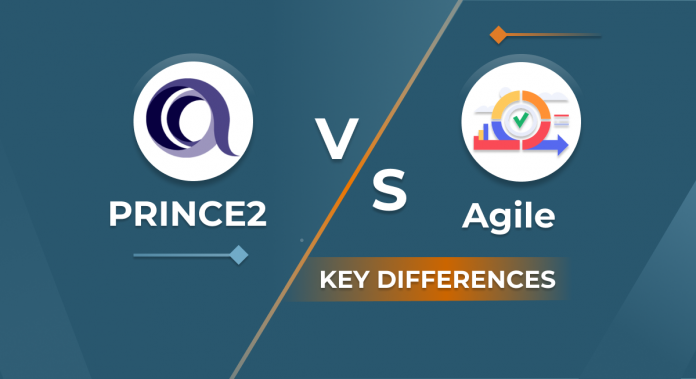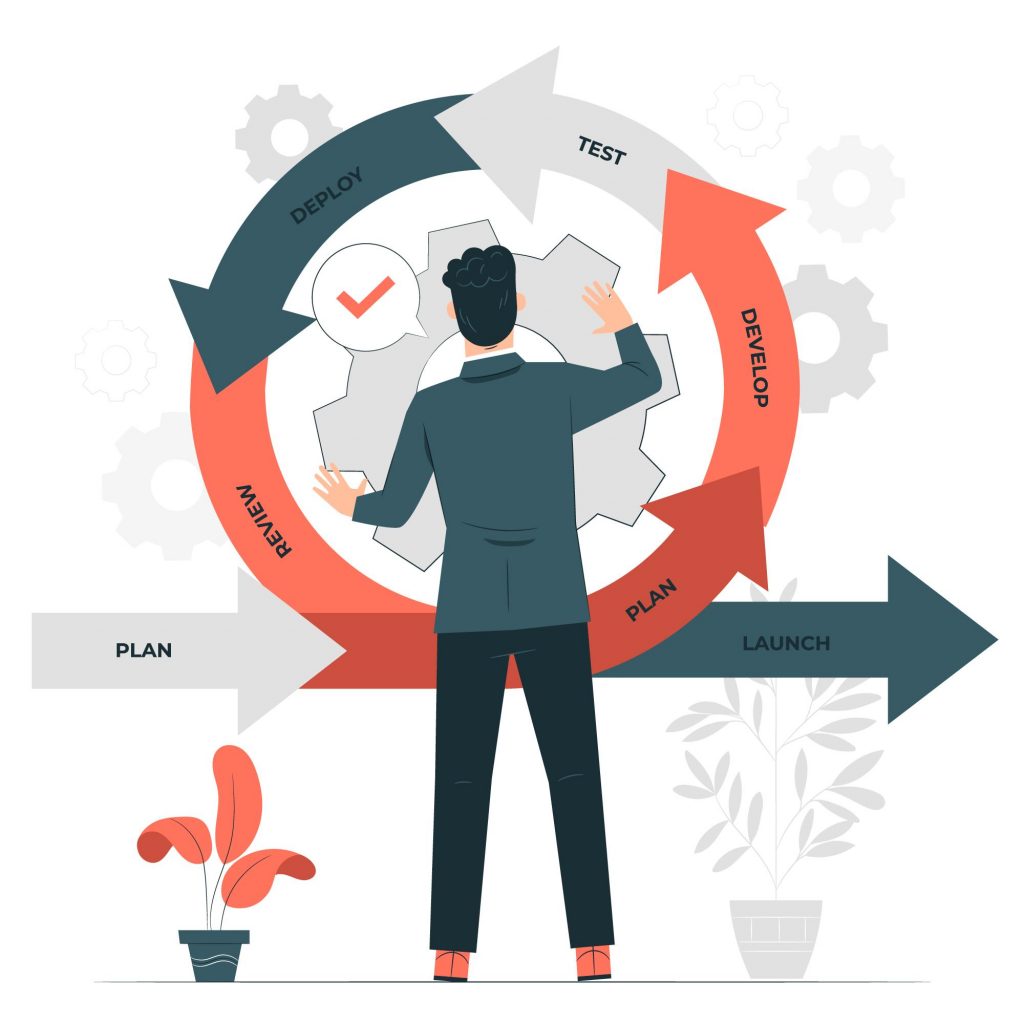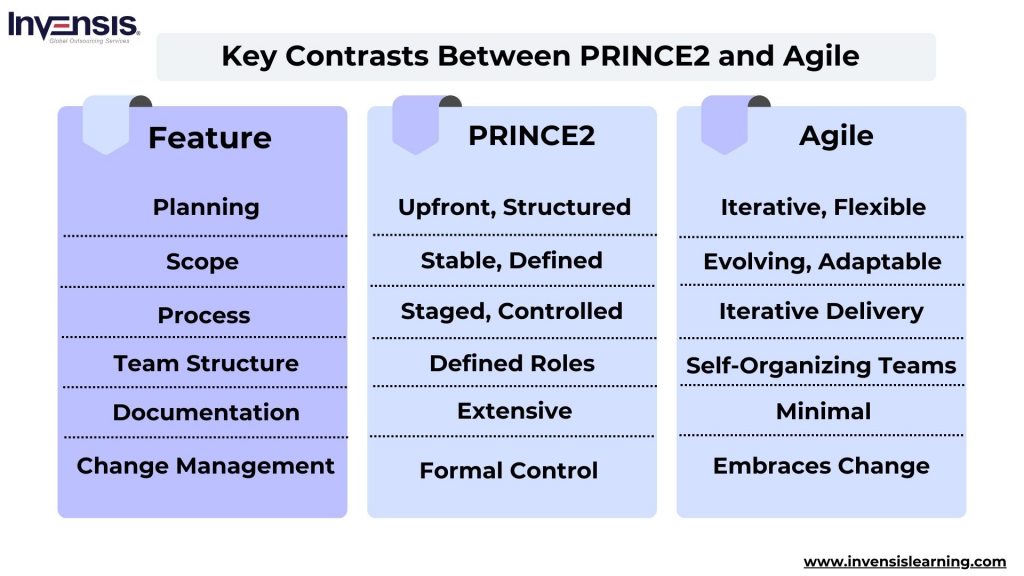
PRINCE2 and Agile are two widely recognized project management frameworks. Given their distinct strengths and weaknesses, choosing between them can be a tough call. PRINCE2 follows a structured, process-driven path, making it perfect for large-scale projects. It’s all about clearly defined roles, responsibilities, and deliverables.
Conversely, Agile takes a more people-centric approach, succeeding in smaller project environments. It emphasizes adaptability, customer feedback, and collaborative teamwork.
This article will help you dive deep into the PRINCE2 vs. Agile debate and highlight its key disparities.
By the end, you’ll have a better grasp of which framework best aligns with your project management objectives. Understanding these differences is essential for success.
Table of Contents
- Prince2 vs. Agile
- Who is PRINCE2 suitable for?
- Who is Agile Suitable for
- Prince2 vs. Agile: Key Differences
- Conclusion
PRINCE2 Vs. Agile – A Comparison
When considering PRINCE2 versus Agile methodologies, the primary distinction lies in their approach to flexibility. Agile is renowned for its adaptability, making it well-suited for software development, where requirements frequently change.
Conversely, PRINCE2 offers a more structured framework, prioritizing stability and predictability, which can be reassuring for projects where consistency is crucial.
Cost is another crucial factor to consider. PRINCE2 typically demands a higher initial investment due to training and implementation costs. However, its planning and risk management processes often result in long-term cost savings by minimizing the possibility of rework or project failure.
In contrast, Agile’s emphasis on quick iterations and responsiveness may incur fewer upfront expenses but could lead to increased costs if requirements evolve unpredictably.
The complexity of the project also plays a key role in determining the most suitable methodology. PRINCE2’s structured approach excels in managing intricate projects with numerous stakeholders and dependencies.
On the other hand, Agile’s iterative development and continuous feedback are better suited for projects with less complexity or those where requirements are subject to frequent changes.
Documentation requirements differ between the two methodologies. PRINCE2 places a strong emphasis on comprehensive documentation, ensuring that project progress, decisions, and risks are well-documented for transparency and accountability.
Conversely, Agile prioritizes working software over extensive documentation, favoring a more streamlined approach that may be advantageous in fast-paced environments.
Efficient resource allocation is another consideration. Agile’s iterative nature allows teams to adapt quickly to shifting priorities, leading to more efficient resource utilization.
In contrast, PRINCE2’s sequential approach may require resources to be allocated upfront, potentially resulting in inefficiencies if project requirements change unexpectedly.
Iteration, duration, and risk management are additional areas of divergence. PRINCE2’s longer iteration cycles offer a comprehensive view of project progress, facilitating better planning and risk management.
Conversely, Agile’s shorter iterations enable rapid feedback and course corrections, which is particularly beneficial for projects with evolving requirements or volatile market conditions.
Additionally, PRINCE2 adopts a formal approach to risk management, systematically identifying, assessing, and mitigating risks throughout the project lifecycle. In contrast, Agile addresses risks in an iterative manner, responding to emerging threats as they arise during project execution.
Who is PRINCE2 suitable for?
PRINCE2 is suitable for a wide range of industries and organizations seeking a structured approach to project management. It benefits managers and teams by prioritizing customer satisfaction and clear decision-making processes.
With its focus on understanding project benefits and justifying investments, PRINCE2 is ideal for organizations in construction, IT, engineering, and manufacturing sectors. Additionally, PRINCE2 is valuable for projects where adaptability to changing conditions is essential, as it provides guidelines for managing projects effectively, even amid shifting environments.
Overall, PRINCE2 suits organizations and individuals who value systematic project management practices, thorough planning, and a customer-centric approach to project delivery.
Who is Agile Suitable for?
Agile methodology, initially tailored for software development, has evolved to suit a broad spectrum of industries and project types. It is particularly suitable for teams that enhance collaboration, productivity, and adaptability.
With its emphasis on iterative development, customer collaboration, and rapid delivery of tangible outcomes, Agile frameworks like Scrum, Kanban, and XP offer structured approaches for managing projects efficiently.
Whether in software development, product development, or other fields, Agile’s flexible nature allows teams to respond rapidly to changing requirements and deliver high-quality results, making it a valuable methodology for any project seeking to improve productivity and customer satisfaction.
Prince2 vs. Agile: Methodological Differences
Comparing PRINCE2 and Agile reveals differences in planning, team structure, and change management approaches. PRINCE2 favors structured planning and documentation for stable scopes, while Agile prioritizes adaptability and collaboration for evolving projects. Recognizing these differences aids in selecting the most suitable methodology for project objectives.
Planning:
PRINCE2: PRINCE2 methodology emphasizes comprehensive planning at the outset of the project. It involves creating a detailed project plan with clearly defined objectives, milestones, and tasks. The plan acts as a roadmap guiding the project team throughout the project lifecycle, ensuring everyone is aligned and aware of their responsibilities.
Agile: In contrast, Agile favors flexible planning. Instead of creating a detailed plan upfront, Agile teams engage in iterative planning cycles. They initially develop a high-level plan and refine it as they progress through the project. Agile planning focuses on adapting to changes and responding to feedback quickly, allowing teams to stay agile and adjust course as needed.
Project Scope:
PRINCE2: PRINCE2 works best in projects with a well-defined and stable scope. It provides a structured approach to managing projects with clear objectives and requirements. PRINCE2 helps ensure the project stays on track and delivers the intended outcomes within the defined scope.
Agile: Agile methodologies, on the other hand, are designed to accommodate evolving or uncertain project scopes. Agile teams embrace change and are equipped to handle shifting priorities and emerging requirements. They prioritize delivering value to the customer over strictly adhering to a predefined scope, allowing for greater flexibility and adaptability.
Process:
PRINCE2: PRINCE2 follows a structured, sequential process with distinct stages, gates, and deliverables. Each stage has predefined objectives and completion criteria, and progress is monitored and controlled throughout the project lifecycle. PRINCE2 provides a clear framework for managing projects methodically from start to finish.
Agile: Agile methodologies adopt an iterative and incremental process. Agile teams work in short cycles or iterations, typically lasting one to four weeks. Each iteration results in a potentially shippable product increment, allowing continuous development and delivery.
Agile processes emphasize collaboration, feedback, and adaptation, enabling teams to respond quickly to changing requirements and deliver value early and often.
Team Structure:
PRINCE2: PRINCE2 defines specific roles and responsibilities for individuals involved in the project. Key roles include the Project Manager, who is responsible for overall project management, and the Project Board, which provides direction and oversight. PRINCE2 ensures clarity and accountability within the project team.
Agile: Agile methodologies promote self-organizing, cross-functional teams. Agile teams are typically small, autonomous groups that work together closely to achieve common goals. Team members are encouraged to collaborate, share knowledge, and collectively make decisions. Agile fosters a culture of empowerment and ownership, allowing teams to innovate and adapt to changing circumstances.
Documentation:
PRINCE2: PRINCE2 requires comprehensive documentation throughout the project lifecycle. This includes documents such as the Project Initiation Document (PID), Stage Plans, and Risk Registers. Documentation formalizes plans, tracks progress, and manages risks effectively. PRINCE2 strongly emphasizes documentation as a means of ensuring transparency, accountability, and traceability.
Agile: Agile methodologies advocate for minimal documentation. While Agile teams still produce documentation, the focus is on delivering working software over extensive paperwork. Agile documentation is lightweight and captures essential information, such as user stories, acceptance criteria, and sprint backlogs.
Agile encourages face-to-face communication and collaboration, valuing working software and direct interaction over comprehensive documentation.
Change Management:
PRINCE2: PRINCE2 employs formal change control processes to manage scope changes effectively. Any proposed project scope, schedule, or budget changes must undergo a thorough evaluation and approval process. PRINCE2 ensures that changes are carefully assessed for their impact on the project’s objectives, risks, and benefits before implementation.
Agile: Agile methodologies embrace change as a core principle. Agile teams welcome feedback and are adaptable to changing requirements and priorities. Changes are incorporated into ongoing iterations, allowing for continuous improvement and evolution. Agile promotes embracing change and leveraging it as an opportunity for innovation and growth.
Conclusion
In conclusion, understanding the key differences between PRINCE2 and Agile methodologies is essential for project managers and organizations aiming to optimize their project management practices.
While PRINCE2 offers a structured approach suited for projects with clear objectives and stable scopes, Agile provides flexibility and adaptability, which is ideal for dynamic and evolving projects.
By recognizing these distinctions, stakeholders can make informed decisions when selecting the most suitable methodology to align with project objectives and organizational needs.
Ready to enhance your project management skills?
Explore Invensis Learning’s PRINCE2 course and Agile Project Management Courses to master these methodologies and drive project success.
















